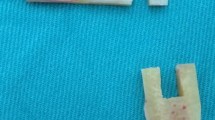Abstract.
Saddle nose is usually caused by a trauma or by excessive resection of the septal cartilage. Nevertheless, there are other, less frequent causes of injury, such as congenital, syphilis, leishmaniosis, and leprosy. Within this context, it is very likely to see widening of the bony bridge and dropping of the tip of the nose. For this clinical status, we found extremely satisfactory a therapy in which we use a dorsum cartilage graft, followed by narrowing of the nasal bridge and shortening of the nose. To achieve this aim, different kinds of materials were employed. The authors usually prefer rehydrated (0.9% saline solution) human costal cartilage. This material was used in a study of a series of patients with saddle nose in which we used open rhinoplasty and cartilage homografts.
Similar content being viewed by others
Author information
Authors and Affiliations
Rights and permissions
About this article
Cite this article
Andrade, M., Fernandes, V. & Boléo-Tomé, J. Saddle Nose: Our Approach to the Problem. Aesth. Plast. Surg. 23, 403–406 (1999). https://doi.org/10.1007/s002669900309
Published:
Issue Date:
DOI: https://doi.org/10.1007/s002669900309




